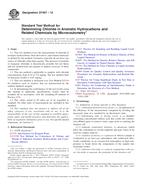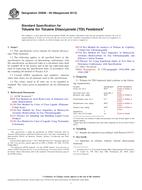Potřebujeme váš souhlas k využití jednotlivých dat, aby se vám mimo jiné mohly ukazovat informace týkající se vašich zájmů. Souhlas udělíte kliknutím na tlačítko „OK“.
ASTM D7457-12
Standard Test Method for Determining Chloride in Aromatic Hydrocarbons and Related Chemicals by Microcoulometry (Withdrawn 2019)
Automaticky přeložený název:
Standardní zkušební metoda pro stanovení chloridů v aromatických uhlovodíků a související chemikálie by mikrocoulometrie
NORMA vydána dne 1.1.2012
Informace o normě:
Označení normy: ASTM D7457-12
Poznámka: NEPLATNÁ
Datum vydání normy: 1.1.2012
Kód zboží: NS-38501
Počet stran: 6
Přibližná hmotnost: 18 g (0.04 liber)
Země: Americká technická norma
Kategorie: Technické normy ASTM
Kategorie - podobné normy:
Anotace textu normy ASTM D7457-12 :
Keywords:
aromatic hydrocarbon, density, electrolysis, electrolyte, evaporation, microcoulometry, potential, pyrolysis, recovery, titration, total chloride, Chloride analysis, Electrolysis, Hydrocarbons (aromatic), Microcoulometry, Titration, ICS Number Code 71.080.15 (Aromatic hydrocarbons)
Doplňující informace
| Significance and Use | ||||||||||||||||||||
|
This test method is useful for determining organic as well as inorganic chloride compounds that can prove harmful to equipment and reactions in processes involving hydrocarbons. The combination of both the organic and inorganic chloride is commonly termed “total chloride” and since the inorganic chlorides are partially recovered, the result for total chloride will be biased low. Maximum chloride levels are often specified for process streams and for hydrocarbon products. Organic chloride species are potentially damaging to refinery processes. Hydrochloric acid can be produced in hydro treating or reforming reactors and this acid accumulates in condensing regions of the refinery. |
||||||||||||||||||||
| 1. Scope | ||||||||||||||||||||
|
1.1 This test method covers the measurement of chloride in aromatic hydrocarbons, their derivatives, and related chemicals as defined by the method. Aromatics typically do not have any source of chlorides other than organic. The presence of metallic or inorganic chlorides is theoretically possible but not likely and this method does not purport to address recovery of those compounds. 1.2 This test method is applicable to samples with chloride concentrations from 0.24 to 5.0 mg/kg. The test method limit of detection (LOD) is 0.07 mg/kg. 1.3 This test method is preferred over Test Method D5194 for products, such as styrene, that are polymerized by the sodium biphenyl reagent. 1.4 In determining the conformance of the test results using this method to applicable specifications, results shall be rounded off in accordance with the rounding-off method of Practice E29. 1.5 The values stated in SI units are to be regarded as standard. No other units of measurement are included in this standard. 1.6 This standard does not purport to address all of the safety concerns, if any, associated with its use. It is the responsibility of the user of this standard to establish appropriate safety and health practices and determine the applicability of regulatory limitations prior to use. For specific hazard statements, see Section 9. |
||||||||||||||||||||
| 2. Referenced Documents | ||||||||||||||||||||
|
Podobné normy:
Historická
1.7.2013
Historická
15.2.2014
Historická
1.7.2014
Historická
15.9.2012
Historická
15.3.2012
Historická
1.6.2012
Doporučujeme:
Aktualizace technických norem
Chcete mít jistotu, že používáte pouze platné technické normy?
Nabízíme Vám řešení, které Vám zajistí měsíční přehled o aktuálnosti norem, které používáte.
Chcete vědět více informací? Podívejte se na tuto stránku.



 ASTM D5606-09(2013)..
ASTM D5606-09(2013).. ASTM D5713-14
ASTM D5713-14 ASTM D5776-14a
ASTM D5776-14a ASTM D5917-12
ASTM D5917-12 ASTM D6526-12
ASTM D6526-12 ASTM D6563-12
ASTM D6563-12
 Cookies
Cookies
